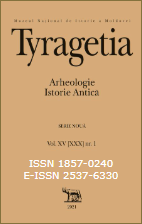An eastern style bronze vessel discovered in Brașov county (Romania)
An eastern style bronze vessel discovered in Brașov county (Romania)
Author(s): Ioan Bejinariu, Florin MoțeiSubject(s): Archaeology, Cultural Anthropology / Ethnology, Prehistory
Published by: Muzeul Naţional de Istorie a Moldovei
Keywords: Bronze Age; Transylvania; Bronze Hoard; Bronze Vessel; North Pontic Region; Long Distance Relations;
Summary/Abstract: The article introduces into scientific circulation an object recently discovered in south-eastern Transylvania, Romania. A few years ago, two prehistoric II. Materiale și cercetări 132 bronze artefacts discovered in the Apașa commune of Brașov County, on the "Șugău" hill, were added to the collection of the Brașov History Museum. Both objects are accidental finds, the archaeological context is unknown. We are talking about a celt and a fragment of a riveted cauldron made of bronze sheet. The relationship between these two objects is not determined, since they were found approximately 70 m from each other. The celt lacks the area of the hole for fixing the wooden handle, and on one of the sides there are three vertical parallel ribs. The fragment of the bronze vessel is the upper part of a cauldron made of riveted horizontal strips of sheet metal. The edge of the vessel is thickened, approximately in the shape of the letter "T". The short neck is approximately cylindrical, followed by a short, slightly profiled shoulder and the body of the vessel, probably truncated-conical. In the area of the joint, the upper band is partially overlapped by the next one, and the bands are riveted. The diameter of the neck of the vessel may be approximately 55 cm. The vessel fragment is 25 cm long and 11 cm high. The closest analogies to the shape of the rim of this vessel can be found in the Northern Black Sea region, among finds in the Republic of Moldova, Ukraine and Russia. So far, this is the only reliable discovery indicating the presence of riveted cauldrons of the eastern type in the late Bronze Age in Transylvania. Hypothetically, this find may be associated with the presence of Noua culture communities in the Late Bronze Age, which is confirmed by archaeological discoveries in southeastern Transylvania.
Journal: Tyragetia (Serie Nouă)
- Issue Year: XV/2021
- Issue No: 1
- Page Range: 123-132
- Page Count: 10
- Language: English

